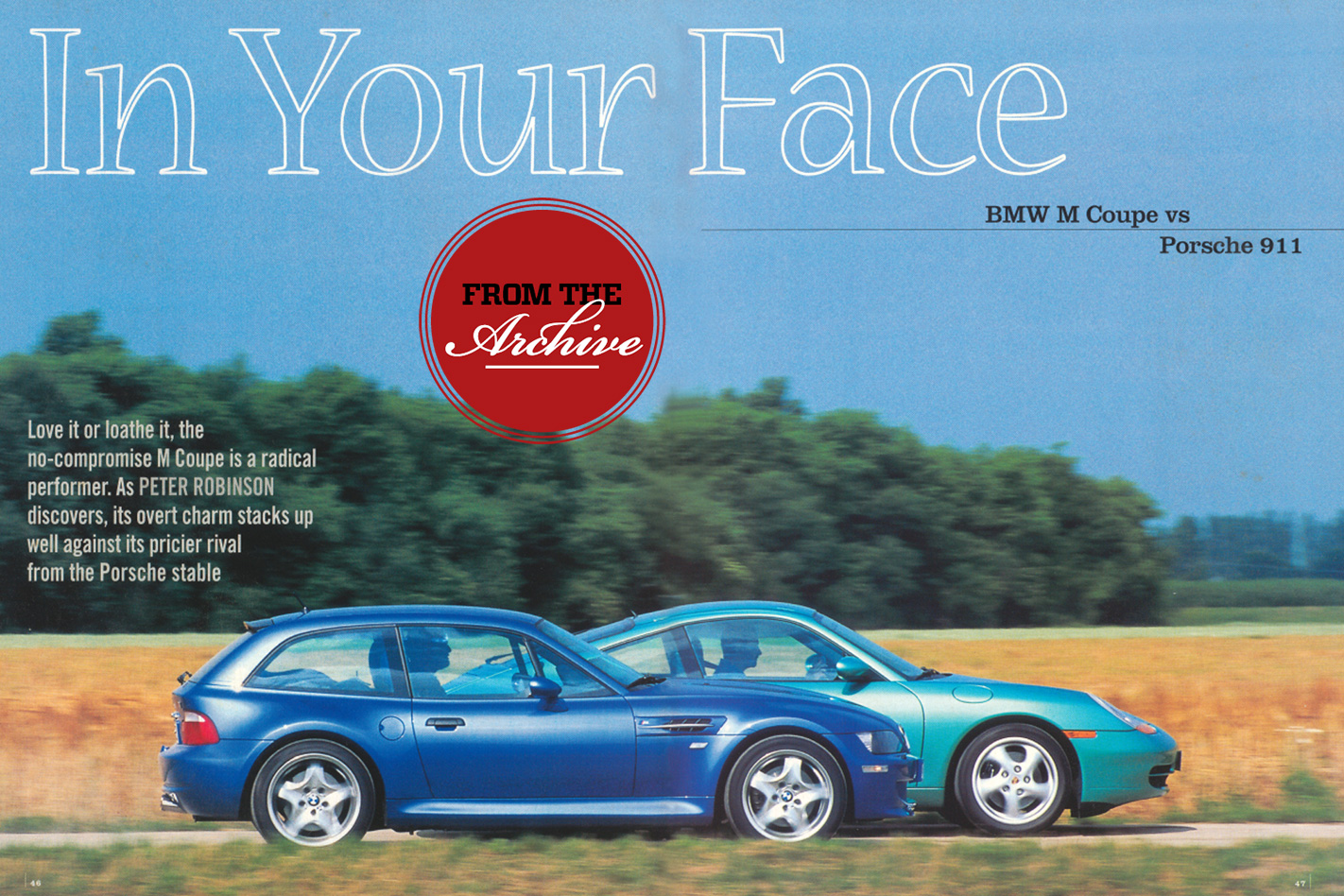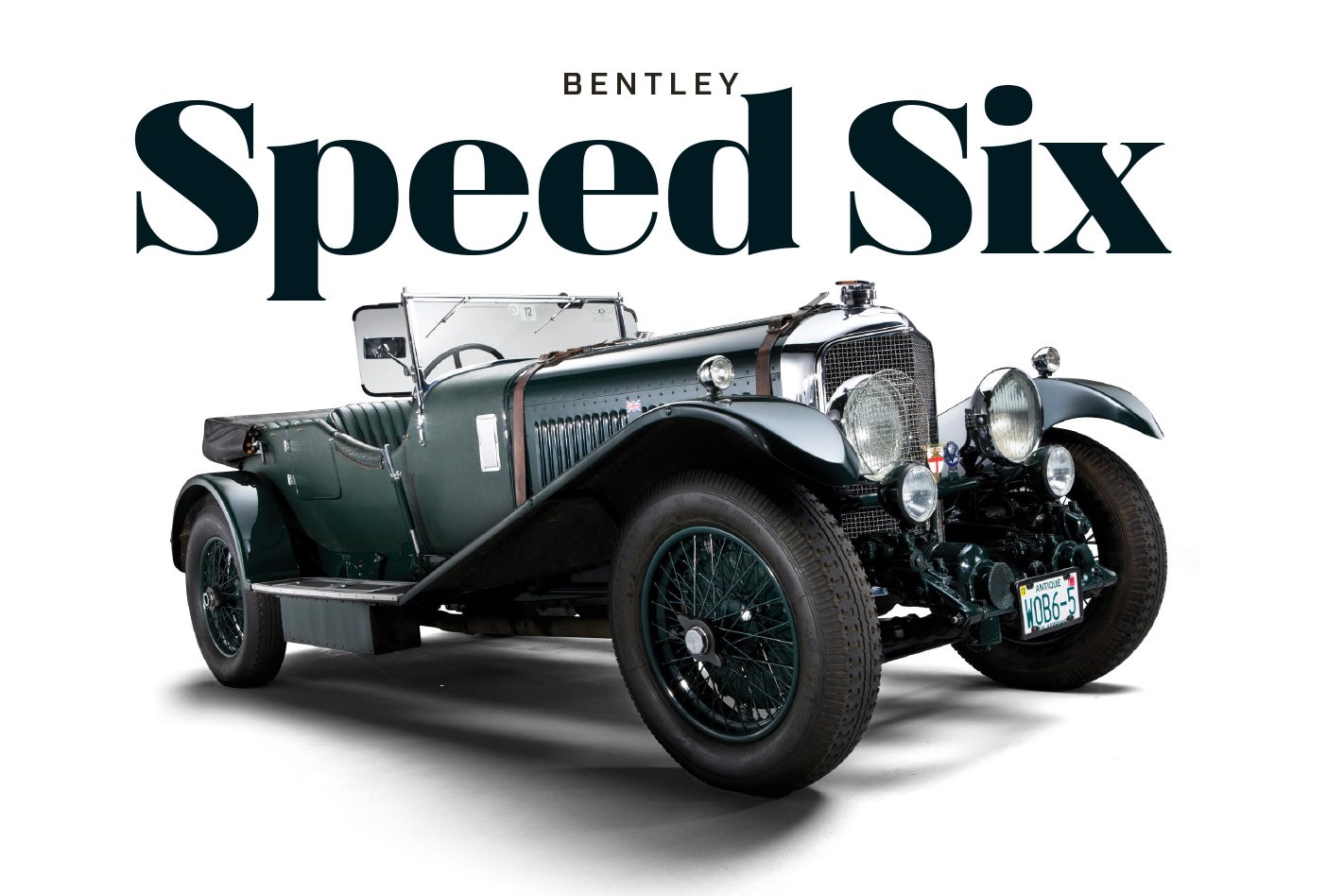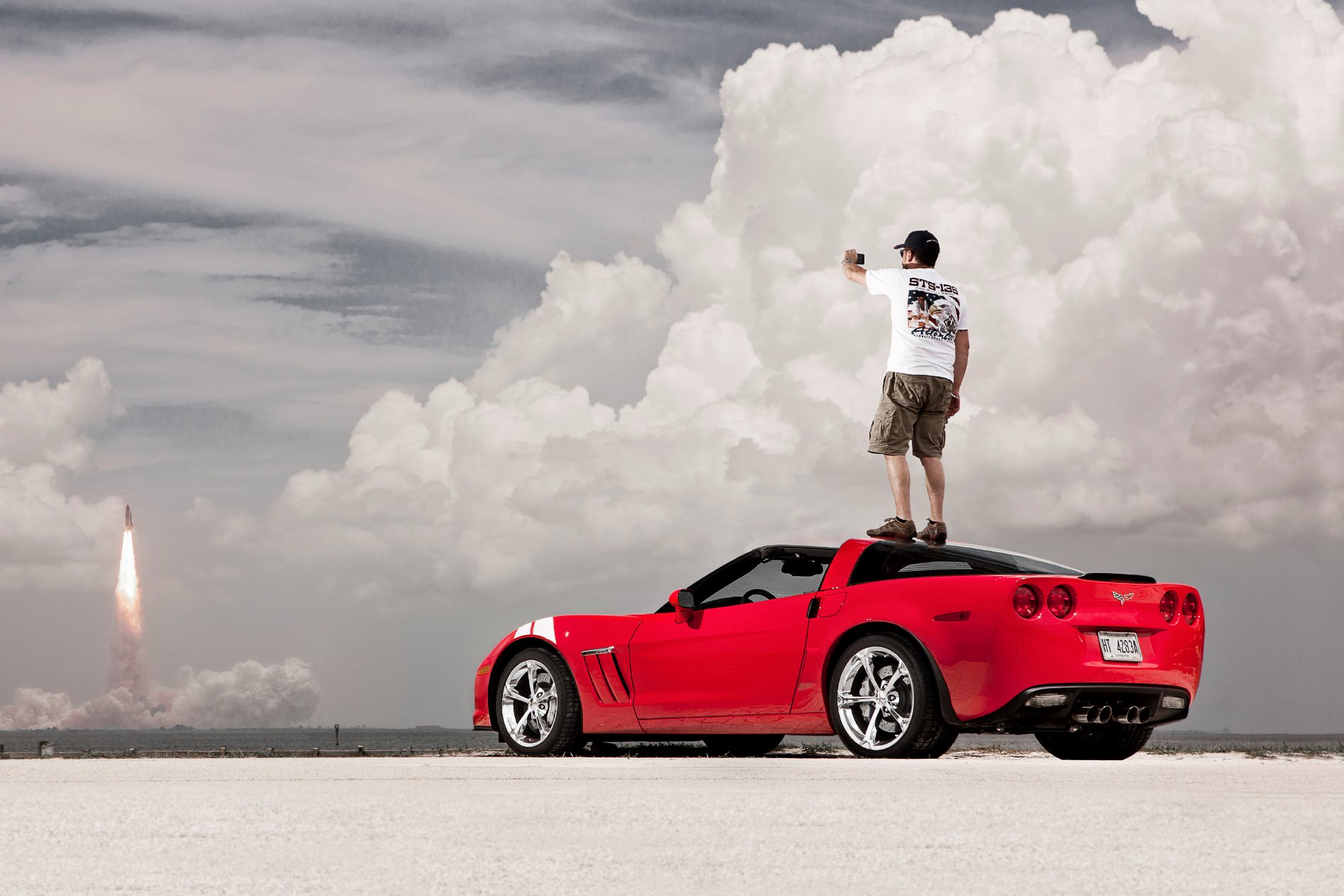Love it or loathe it, the no-compromise M Coupe is a radical performer. As Peter Robinson discovers, its overt charm stacks up well against its pricier rival from the Porsche stable.
First published in Wheels in September 1998, Australia’s best car mag since 1953.
HALF of you are absolutely going to hate the way BMW’s new Z3 Coupe looks.
Does Munich care? Not at all. BMW understands perfectly that nobody, but nobody, is going to be indifferent to the new Coupe. This is BMW being controversial, outrageous, deliberately shocking. And totally unconcerned about your reaction.
“This car is not built to be everybody’s darling,” says an unrepentant Dr Wolfgang Reitzle, DMW’s product boss. “We see the buyers as real individualists who love the unusual styling,” says Jurgen Pawlik, the bloke in charge of product management at M GmbH, BMW’s specialty car division responsible for the Coupe’s creation. “I don’t think any (buyers) will ask if the neighbours like the car.”
The subject of this debate (and it was only after the all-powerful Reitzle gave the Coupe his blessing that internal arguments ceased, at least in public) is exactly as it’s clumsy Z3 M Coupe name implies – a Coupe version of the Z3 M Roadster.
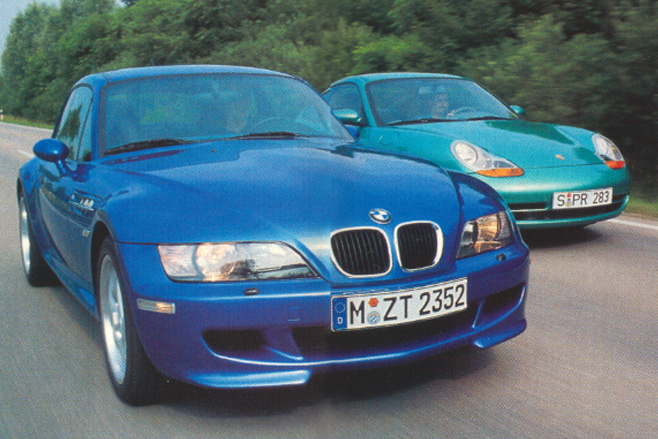
The bowed belt-line breaks every styling principle. The narrowness of the cabin only exaggerates the already brawny, bulging wheel arches over huge 245/40ZR17 Michelins. From behind, the combined width of the wildly protruding wheel housings seems as broad as the cabin itself in profile, the expansive bonnet looks at least as long as the roof. From three-quarters front-on, the Coupe hunches down over the rear wheels, ready to strike. The driver sits way back – just ahead of the rear axles – while the taper of the tail suggests rear overhang is virtually non-existent.
Forget cab-forward, this is cab-back design and intentionally so, producing proportions so dramatic they are utterly alien to the efficient packaging of most of today’s (and not just front-drive) cars. It’s hard to imagine any manufacturer seriously contemplating producing so fearlessly bold a car. The Z3 M Coupe is brutal, not elegant; exciting, not bland.
No way does it look as if it were designed from a clean sheet of paper; more that it evolved as a Californian custom car – a Boyd Coddington original.
And that’s exactly the way it happened. When the early Z3 prototypes reached the full-sized stage, the engineers immediately realised the potential for a genuine GT car. They knew a stiffer body would improve refinement and provide more responsive handling. In secret – for the Z3 was planned only as a Roadster – a five-man team met after normal working hours in the underground garage of the R&D centre and turned the ragtop into a coupe.
At first they didn’t bother to involve the styling department. Only after removing the rear fenders and boot lid, and as they began to cover the body with roof bars, foam plastic, wood and surface foil, was a single, friendly designer called in.
“It was like building a car in the old days,” admits one of the five. No full-sized computerised sketches, no detailed drafting drawings, just five men creating a new car in their own time, outside BMW’s normally regimented development process.
Should be more of it. Only when the wood/clay 1:1 mock-up was finished did they dare show the car to Reitzle. Once he gave the go-ahead for further development the arguments began.
Says Dr Burkhard Goschel, the project manager for special projects: “Some people saw it and were thrilled. Others were … let’s say, more reserved. There was a long debate on the car, with extreme opinions. There was nothing in-between. If you didn’t love it at first sight, you hated it. In the end, we decided emancipated navigators would buy the car.”
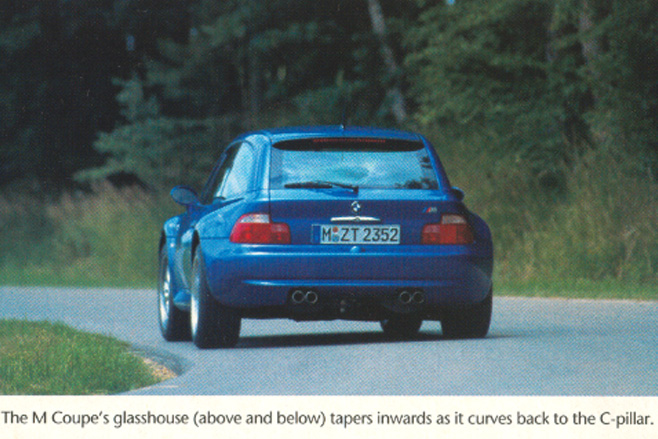
Munich’s example has inherited something of an American muscle car flavour, though this has nothing to do with the fact that, like all Z3 variants, it’s built in Spartanburg, South Carolina. For this first drive, we choose to compare the M Coupe to its closest current rival, Porsche’s new 911 Coupe.
Early on, BMW toyed with the idea of building the Coupe with the same four-tiered range (five if you include the American-only 179k W 3.2 M) of engines offered in the Roadster. Then it was decided a 1.9 Coupe didn’t provide sufficient performance to be sporting, happily ignoring the implications in such a statement for the ragtop. It was decided the two sixes – 2.8 and 3.2 litres – create true GT cars. For the moment, BMW Australia has decided not to import the 2.8 and will only offer the M Coupe. In Germany, M Coupe and Roadster are the same price and that’s our prediction for Australia – hence the $135,000 estimate. Munich won’t talk production figures, but suggests the Coupe could represent 20 percent of Z3 production, or around 10,000 a year. There’s the reason it can be so dismissive about your view of its appearance. An entry level Coupe? Maybe next year when the 1.9-litre four is replaced by BMW’s smoother and more powerful 2.0 litre six, in the Roadster.
Mechanically, nothing is changed for the M Coupe – at least on paper. There’s the same 236kW firepower of the 3.2-litre double VANOS inline six from the M3. Same astonishing tractability from 1800rpm; same unburstable lustiness to the 7400rpm redline. The extra 20kgs of weight – all that extra glass – and unchanged gearing (still through a five-speed box because the six-speeder won’t fit under the Z3 floorpan), mean BMW’s claimed performance of the Coupe and Roadster are identical. That means a tyre-shredding 5.4sec to 100km/h and an electronically limited 250km/h top speed.
Likewise the semi-trailing arm rear suspension from the now two-generations-old 3 Series models and, of course, today’s Compact. Even so, a transformation has taken place. Drive the Coupe on anything less than a billiard-table smooth road and you know something fundamental has changed.
Despite the best efforts of BMW to improve the body rigidity of six-cylinder Z3s over the shaky 1.9, the M Roadster’s dashboard shakes and the body shimmies and trembles on rough roads. Bump deflection is impossible to avoid, the steering feels heavy-handed and turn-in slower than you expect, disappointingly reducing the handling potential. The result, despite the awesome performance, is unsatisfying. Enter the Z3 M Coupe – an altogether more capable driving machine.
Crucial to this transparent improvement is body rigidity that’s more than double the Roadster. BMW is sufficiently sensitive not to reveal exact torsion figures, but the improvement is definitely discernible. And not just because it has allowed the engineers to subtlety fine tune the suspension by slightly finning up both springs and dampers (the anti-roll bars are unchanged). Although the steering itself isn’t changed, the Coupe feels more agile and more cohesive with front and rear suspension now working in unison.
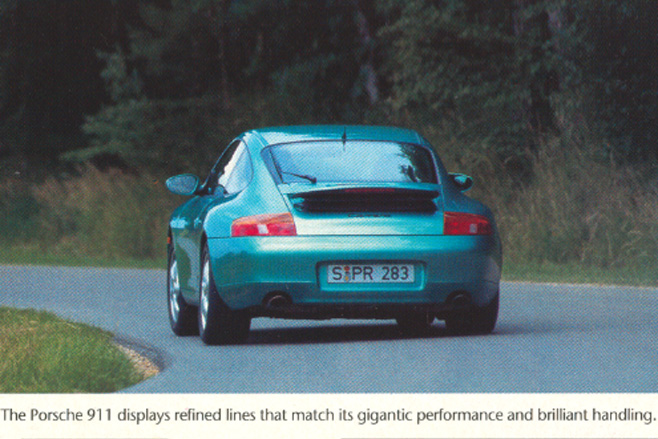
Like the M Roadster, the Coupe has no traction control so no electronic gimmickry breaches a direct relationship between driver’s right foot and the massive rear rubbers. On a dry road your right foot dictates the cornering attitude, which varies from a mild understeer to power oversteer or, once you get the hang of it, a satisfying neutral stance, the driver balancing and varying the car’s cornering attitude via power inputs. Even the mighty compound brakes feel more powerful than those on the Roadster.
Park the M Coupe next to our 911 and it looks much smaller and wilder. It might be a significant 405mm shorter but, for on-road presence, it overshadows the more discreet Porsche. Few contemporary cars demand your attention like the M Coupe. Of course, it’s not really a coupe at all – not in the way of the 911. More sports wagon. Adding a long, fixed steel roof and an opening tailgate has created the ultimate hot-hatch. Except the longitudinally-mounted front engine drives the rear wheels.
With its long bonnet proportions the M Coupe couldn’t be anything but front-engine/rear drive. By siting the cabin, and especially its two occupants, in the rear half of the 2459mm wheelbase and locating items like the battery in the floor of the boot the BMW has retained the customary 50/50 weight distribution.
In Porsche’s 50-year history the standard engineering practice has been a horizontally-opposed, so-called Boxer, engine mounted in the rear. The 911’s all-new powerplant is water-cooled, of course, but it’s still stuck out beyond the rear axle line, so a seemingly unfashionable 61 percent of weight hovers over the rear wheels, so the Porsche remains tail heavy.
Weissach added four valves per cylinder and quad cams, but even so, and despite an extra 186cm3, the Porsche can’t quite match the output of the BMW. The M Coupe achieves precisely the once magic 100bhp (74.57kW) per litre. The 911s 87bhp per litre means it produces 221kW at 6800rpm with a 7300rpm redline, just 100rpm shy of the long-stroke BMW. Despite the disparity in their layouts, both engines pump out an identical 350Nm of torque, though the BMW peaks at 3250rpm and the Porsche at a rather higher 4600rpm.
The 911 has a number of small advantages over the M Coupe. Individually, they might not be so important; together they add up. First, the Porsche has a six-speed gearbox with a closer spread of lower ratios and a taller top gear; second, it weighs 70kgs less than the more diminutive BMW; third, the 911’s 0.30 drag co-efficient is significantly more slippery than the Z3’s 0.37. Finally, the 911’s 64-litre fuel tank provides a reasonable, if far from generous, touring range while the BMW’s puny 51-litre capacity is woefully inadequate, despite marginally better fuel consumption. Point out these flaws and BMW will ask the obvious. Are the Porsche’s advantages, and its bigger two plus two cabin, worth another 50 thousand when the performance is so close?
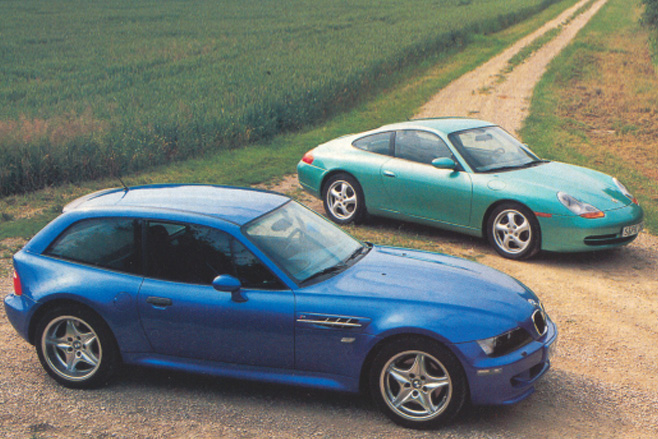
911-ness of character has been engineered out of the new car.
Maybe, in truth, such people were exactly those the BMW engineers had in mind when they developed the M Coupe. By the standards of the new Porsche, this is a raw beast, loud, aggressive and extroverted. Not quite as quick, it’s true, though in the real world the difference is minimal. The point, here, is that the M Coupe actually feels and sounds more explosive than the civilised 911. Does perception become reality? Not quite. Stir the Porsche and its supremely smooth and seamless engine produces an intoxicating howl from the tail that’s more than a match for the rumbling extravagances of the aurally more high-strung BMW.
Yes, the 911’s steering is lighter; the constant writhing that some people miss has been filtered out, leaving only the information the driver really needs. On the other hand, the M Coupe’s steering is heavier, less direct and communicative, despite the huge advance over the Roadster in feel and agility. It’s still the Porsche that’s the more nimble, coherent and accurate.
This is the first new Porsche 911 I’ve driven on the standard 17in rubber and wheels and the ride is predictably more supple and absorbing than on the optional 18s. The M Coupe, too, rides superbly for a car on such low profile tyres, but it can’t match the compliance or body control of its rival and is occasionally caught out over manhole covers or deep potholes.
Both 911 and M Coupe deliver huge performance, responsive handling, fabulous brakes and massive grip. The BMW can still spin both rear wheels exiting a tight first or second gear corner under full noise – even on a dry road.
Back off in the 911 and the tail still edges out, yet so benign is its behaviour that there will be those who prefer the M Coupe’s flagrant power oversteer. For both, 200km/h autobahn cruising is a doddle. At these speeds, and above, the BMW actually has a small but clear advantage in stability.
The M Coupe’s cabin is tiny and forward of the seats. It offers an awkward, cramped (for the tall) driving position with non-adjustable steering wheel and gaudy retro-instruments. Boot space has grown from the Roadster’s 165 litres to 210-410 litres (if you load the boot up to the roof and use the safety net) – just enough for two people on a weekend away.
Fortunately, the BMW has the better seats – beautifully comfortable and dished buckets that hold you in place and are fully supportive. In contrast, the seatbacks on the 911 are too narrow, especially at shoulder height. But the pedals and steering wheel are square to the driver, so the Porsche locates the driver more comfortably in an open, airy cabin that is (mostly) tastefully trimmed in leather. The exception being some cheap dashboard plastics which lower the tone.
These two sports cars provide enough drama for any well-heeled enthusiast, but that doesn’t stop the 911 from being the better car. More refined, yes – but also more multi-talented.
But you can’t ignore the overt appeal of the brutal M Coupe. To state the obvious, the Z3 M Coupe is not a car for the bashful. Before you choose between the Roadster and Coupe twins, remember that the hardtop offers a vastly more enjoyable and rewarding driving experience, combining brutal acceleration with a welcome layer of refinement. The bold in-your-face styling won’t appeal to everybody but, if you love the look of the Z3 M Coupe, you will love it beyond any other car.

